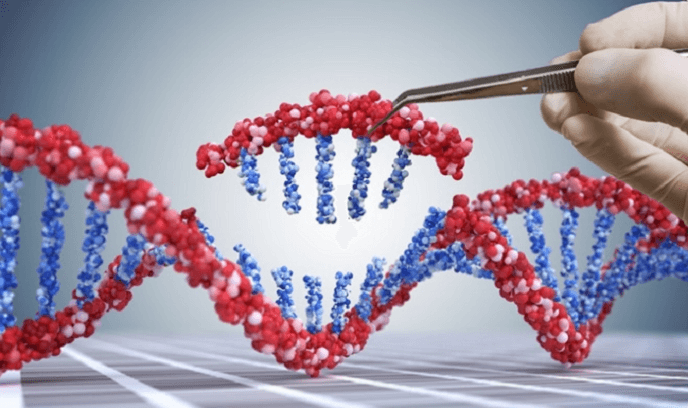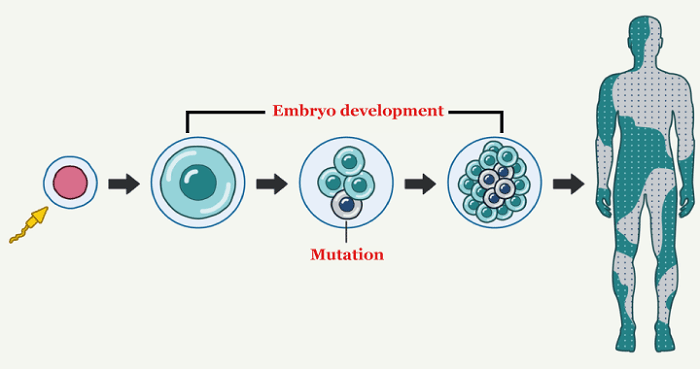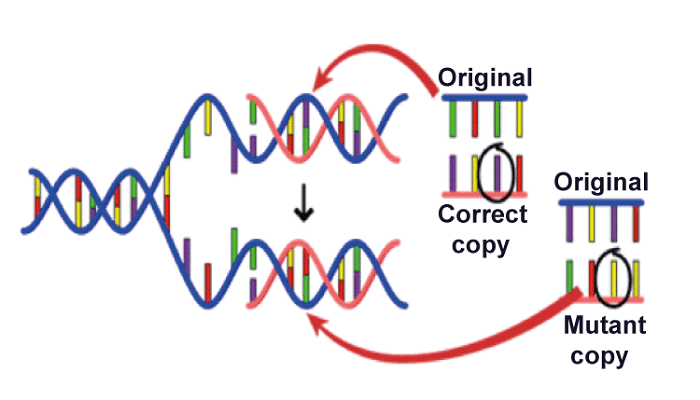Mutation DefinitionA mutation in biology is a modification to the sequence of nucleic acids of an organism's, viruses, or extrachromosomal DNA. The viral genome may contain DNA or RNA. Mutations may be caused by mistakes in DNA replication, "viral replication", mitosis, "meiosis", or other forms of DNA damage, like pyrimidine dimers from ultraviolet light exposure. The damaged DNA may subsequently undergo error-prone repair, especially microhomology-mediated end joining, result in an error during one of those types of repair, or cause an error during replication. In addition, DNA insertions and deletions can result in alterations owing to mobile genetic elements. A mutation may or may not impact an organism's phenotype or observable characteristics. Evolution, cancer, and the maturation of the immune system, especially the junctional variety, are just a few of the biological processes, both normal and malignant, that are impacted by mutations. The mutation is the source of all genetic diversity and is also the mechanism by which evolutionary processes like natural selection function. 
Sequence changes can take many distinct forms as a result of mutation. Gene mutations can have no effect, change the gene's product, or stop the gene from working fully or correctly. Non-genic areas are likewise susceptible to mutation. A 2007 report on the genetic variations among the Drosophila species found that the outcome of a mutation that modifies a protein produced by a gene is probable to be disastrous. An estimated 70% of amino acid polymorphisms are thought to have negative effects, with the remaining 20% being neutral or marginally positive. Since mutations can negatively affect genes, animals have mechanisms like DNA repair that can stop or reverse mutations by restoring the original state of the altered region. OverviewThe majority of the time, mutations are caused by genetic recombination, which can result in large regions of DNA duplicating. Animal genomes duplicate between tens and hundreds of genes per million years, providing a sizable source of genetic information for the creation of new genes. Their sequence similarity amongst genes as members of bigger gene families with common ancestry. Novel genes can be created in various ways, most frequently by duplicating and mutating an ancestral gene or by recombining pieces of other genes to create new combinations with novel functions. Protein domains serve as modules in this context, each with a distinct and independent function that can be combined to create genes that code for new proteins with distinctive features. For example, the four genes that the human eye uses to create its light-sensing structures?three for cone cells, which are responsible for colour vision, and one for rod cells, which are responsible for night vision?all descended from a single ancestor gene. One gene in a pair can perform a novel role since engineering redundancy can be increased by duplicating a gene or even an entire genome. The other copy, meanwhile, keeps performing as designed. This is another benefit of gene duplication. Occasionally, new genes are produced by different mutation types from noncoding DNA. Larger mutations, in which DNA fragments within chromosomes break & subsequently reorganize, may also be involved in changes in chromosome number. For example, human chromosome 2 was created by the fusion of two chromosomes in the Homininae; however, this fusion did not take place in the lineage of the other apes, & these separate chromosomes remain in those species. Such chromosomal rearrangements may play the most significant role in evolution by accelerating the divergence of a generation into unique species by reducing the likelihood of interbreeding and maintaining genetic diversity among populations. Transposable DNA sequences, which comprise a significant portion of the genetic makeup of plants and animals, may have played a key role in developing genomes since they can migrate about the genome. The Alu sequence, found in the human genome in more than a million copies, has been enlisted to carry out tasks like controlling gene expression. These mobile DNA sequences also have the potential to delete or modify existing genes within a genome as they travel around, leading to the creation of genetic diversity. Genetic variety increases due to nonlethal mutations accumulating in the gene pool. Natural selection can limit the frequency of some genetic mutations within the gene pool, but other "more attractive" mutations may accumulate & lead to adaptive modifications. Mutation Causes There are four different types of mutations:
Also, by manipulating DNA, scientists can intentionally introduce mutation sequences to conduct scientific investigations. According to a 2017 study (whose population was spread across 69 nations), 29% of cancer-causing mutations are caused by the environment, 66% result from random mutations, and 5% are passed down through the family. Humans pass on 60 new mutations to their offspring on average, while dads pass on more mutations based on age, contributing 2 additional mutations to a child every year. 
A Spontaneous MutationA non-zero chance of spontaneous mutations occurring even in a healthy, uncontaminated cell exists. In rats and humans, it is believed that naturally produced oxidative DNA damage occurs 100,000 times and 10,000 times per cell, respectively, every day. The specific alteration given below can be used to identify spontaneous mutations:
Bypassing Replication ErrorsThere is growing evidence that most naturally occurring mutations come from template DNA Strands damage experienced during replication that is prone to errors (translesion synthesis). The bulk of mutations in mice are brought on via translesion synthesis. Similar results were obtained in yeast, where Kunz et al. discovered that translesion synthesis was responsible for more than 60% of spontaneous single-base pair changes and deletions. Mistakes made during DNA repairEven though DNA experiences double-strand breaks naturally only sometimes, when they do, the repair process frequently results in mutation. Non-homologous end joining is a crucial technique for repairing double-strand breaks. The process of NHEJ entails the removal of a few nucleotides to allow for the somewhat erroneous alignment of the opposite edges for re-joining, followed by the addition of nucleotides to fill up any gaps. As a result, NHEJ frequently causes mutations. Induced MutationsGene changes caused by environmental factors and mutagens are known as induced mutations. On a molecular level, induced mutations can happen due to the following:

Radiation
Molecular pathways for the mutation have indeed been discovered in bacteria and throughout the tree of life. In contrast, previously, it was thought that mutations happened by chance or were driven by mutagens. According to S. Rosenberg, "These processes present a picture of highly controlled mutagenesis, up-regulated temporally by stress responses & activated when cells/organisms are stressed-potentially quickening adaptation." The SOS reaction in the bacterium, ectopic intrachromosomal crossover, and other chromosomal processes like duplications are examples of processes occasionally referred to as "adaptive mutagenesis". These are self-inflicted mutagenesis mechanisms that quicken organisms' rate of adaptability.
Next Topic#
|
 For Videos Join Our Youtube Channel: Join Now
For Videos Join Our Youtube Channel: Join Now
Feedback
- Send your Feedback to [email protected]
Help Others, Please Share









